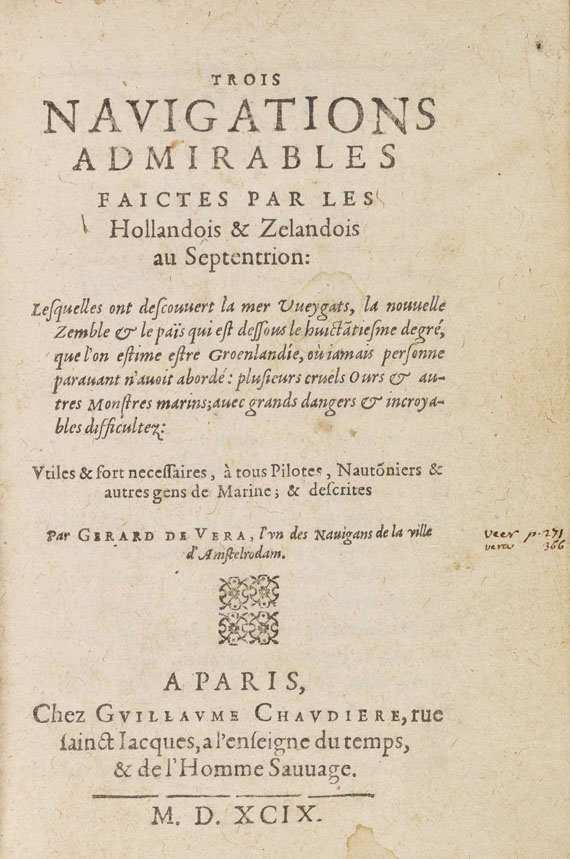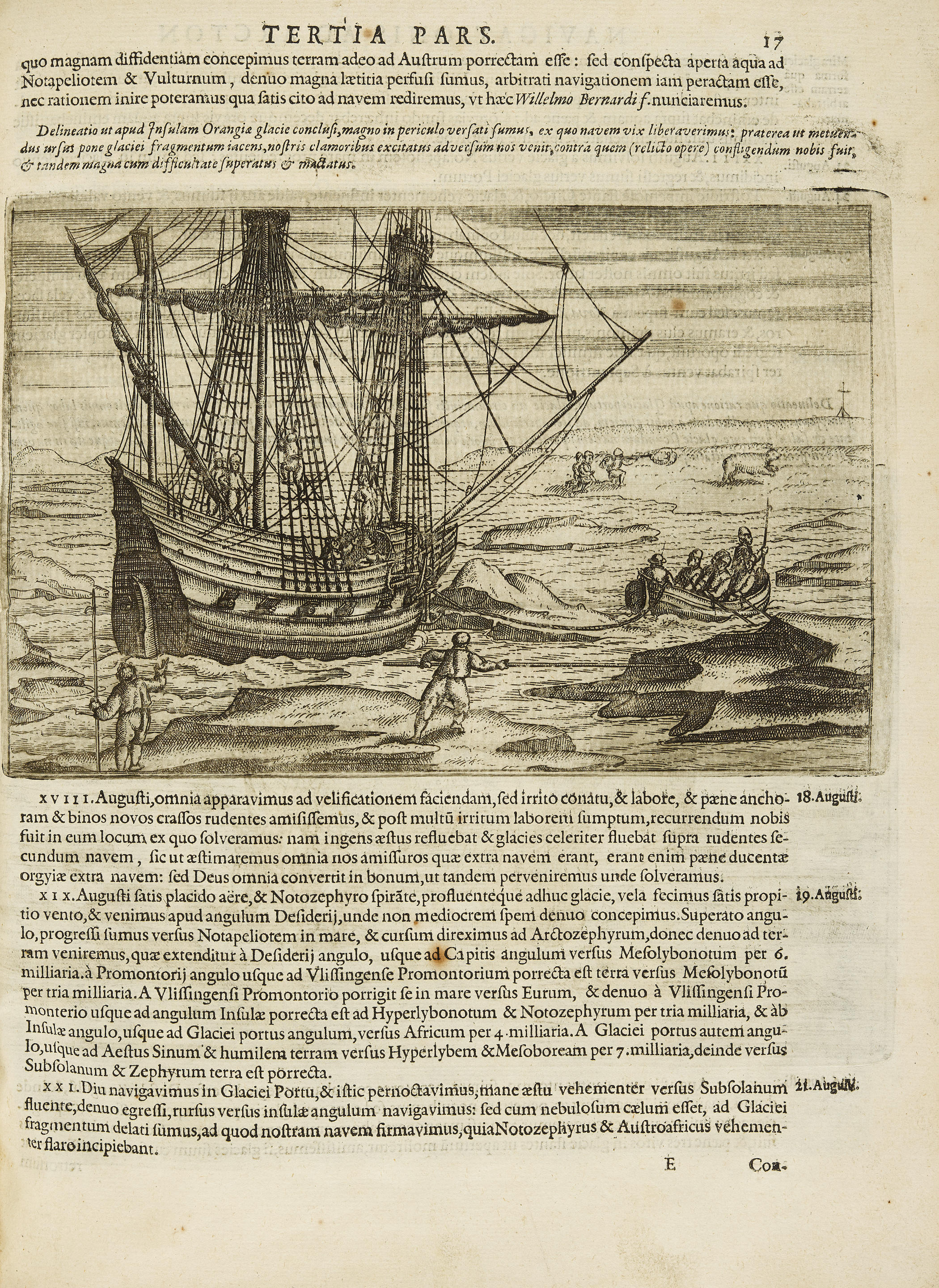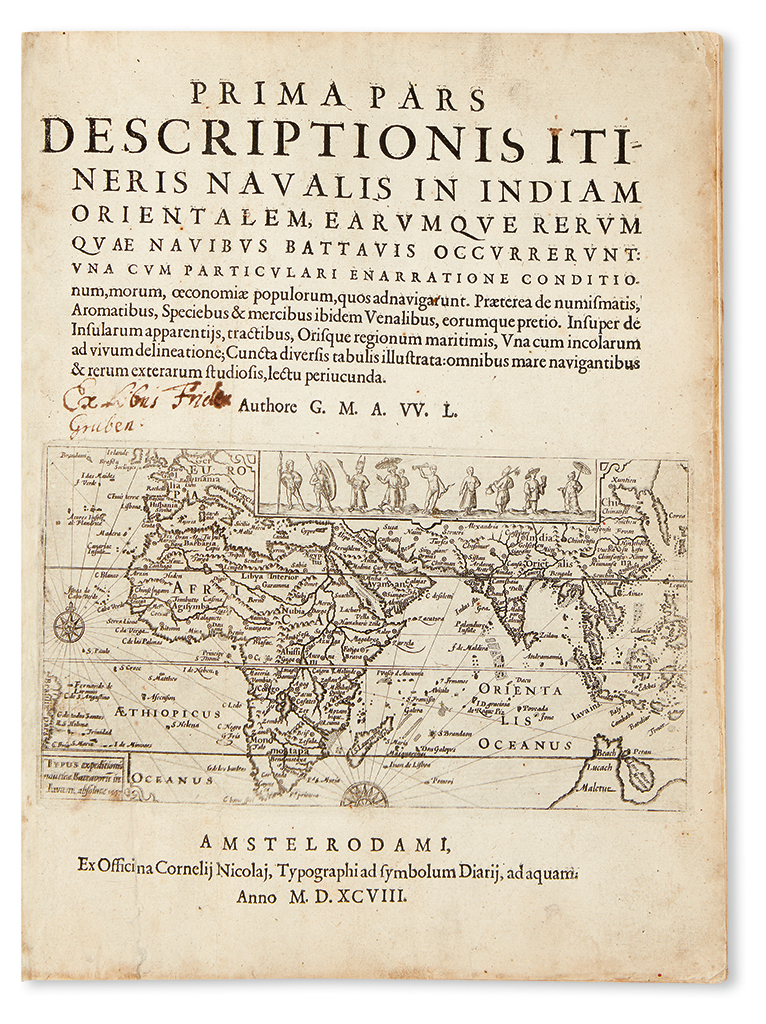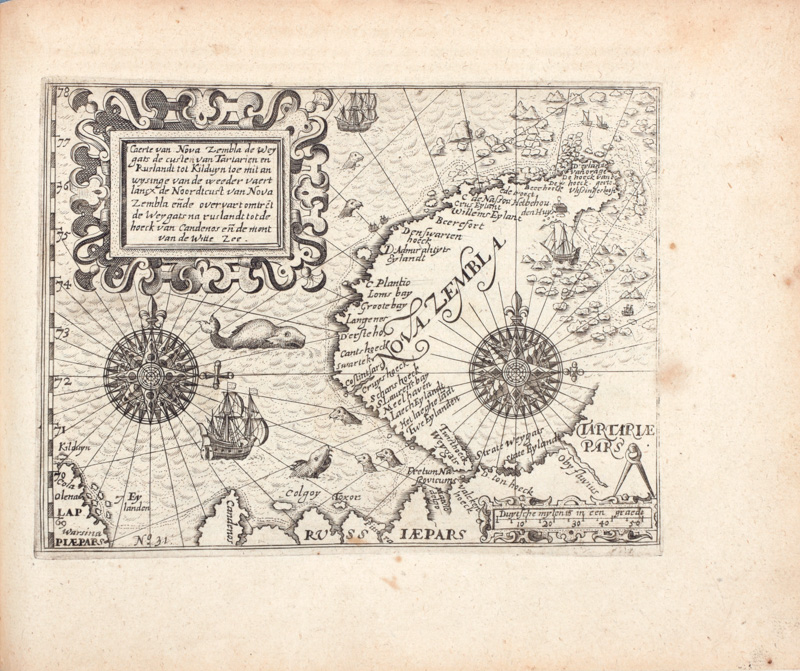Veer, Gerrit deTre navigationi fatte dagli Olandesi e Zelandesi al settentrione della Norvegia, Moscovia e Tartaria verso il Catai e regno de' Sini, dove scopersero il mare di Veygatz, la Nuova Zembla et un paese nell'ottantesimo grado creduto la Groenlandia. Venice: Battista Ciotti, 1599
4to (200 x 146 mm). collation: a4 A–V4: 84 leaves (V4 blank). Engraved vignette on title, 32 half-page engraved illustrations and maps (2 printed in sanguine), woodcut initials and headpieces; quires G–I lightly browned, four text engravings just barely shaved. Contemporary limp vellum, plain endpapers and edges, remnants of two pairs of ties, title inked on spine. Half red morocco slipcase.
First Italian edition of a major work of Arctic exploration, describing Willem Barentsz's three voyages in search of a Northeast Passage, two in the company of Huyghen van Linschoten. The author, Gerrit de Veer, served as ship's carpenter on the final two expeditions and based his account largely on his own diary. Most of the book is devoted to the third voyage of 1596–1597, one of the most celebrated in the history of polar exploration: after their ship was trapped in the ice near Novaya Zemlya, the company was forced to make the first over-wintering within the Arctic Circle. During the crew's makeshift winter quartering, de Veer was the first person to record the polar mirage now known as the Novaya Zemlya effect.
The crew built a cabin from driftwood, which they named "Het Behouden Huys" (The Saved House), where they waited out the frigid winter, though many perished along the way. The engraved illustrations provide a vivid supplement to the description of the events — including depictions of crew's attempt to fend off of polar bears, to which several would succumb — but do not illustrate the games of coif (or golf) which provided exercise during the long and difficult winter months. In June 1597, after almost a year, with their ship still stuck in the ice and now occupied by polar bears, the surviving crew sailed and sledged in two open boats 1600 miles around the northern cape, down the length of Novaya Zemlya, and out across the White Sea to safety on the Kola Peninsula, where they found three Dutch ships, one commanded by Jan Cornelisz Rijp. Barentsz and several crew died of scurvy prior to the rescue. The ruins of hut in which the company over-wintered was later found by Norwegian whaler Elling Carlsen in 1871.
Translated by Giovanni Giunio, Tre navigationi fatte dagli Olandesi e Zelandesi was simultaneously issued over the imprint of Jeronimo Porro.
REFERENCES:Adams V317; Edit16 59013; European Americana 599/90; Mortimer, Italian 521
Veer, Gerrit deTre navigationi fatte dagli Olandesi e Zelandesi al settentrione della Norvegia, Moscovia e Tartaria verso il Catai e regno de' Sini, dove scopersero il mare di Veygatz, la Nuova Zembla et un paese nell'ottantesimo grado creduto la Groenlandia. Venice: Battista Ciotti, 1599
4to (200 x 146 mm). collation: a4 A–V4: 84 leaves (V4 blank). Engraved vignette on title, 32 half-page engraved illustrations and maps (2 printed in sanguine), woodcut initials and headpieces; quires G–I lightly browned, four text engravings just barely shaved. Contemporary limp vellum, plain endpapers and edges, remnants of two pairs of ties, title inked on spine. Half red morocco slipcase.
First Italian edition of a major work of Arctic exploration, describing Willem Barentsz's three voyages in search of a Northeast Passage, two in the company of Huyghen van Linschoten. The author, Gerrit de Veer, served as ship's carpenter on the final two expeditions and based his account largely on his own diary. Most of the book is devoted to the third voyage of 1596–1597, one of the most celebrated in the history of polar exploration: after their ship was trapped in the ice near Novaya Zemlya, the company was forced to make the first over-wintering within the Arctic Circle. During the crew's makeshift winter quartering, de Veer was the first person to record the polar mirage now known as the Novaya Zemlya effect.
The crew built a cabin from driftwood, which they named "Het Behouden Huys" (The Saved House), where they waited out the frigid winter, though many perished along the way. The engraved illustrations provide a vivid supplement to the description of the events — including depictions of crew's attempt to fend off of polar bears, to which several would succumb — but do not illustrate the games of coif (or golf) which provided exercise during the long and difficult winter months. In June 1597, after almost a year, with their ship still stuck in the ice and now occupied by polar bears, the surviving crew sailed and sledged in two open boats 1600 miles around the northern cape, down the length of Novaya Zemlya, and out across the White Sea to safety on the Kola Peninsula, where they found three Dutch ships, one commanded by Jan Cornelisz Rijp. Barentsz and several crew died of scurvy prior to the rescue. The ruins of hut in which the company over-wintered was later found by Norwegian whaler Elling Carlsen in 1871.
Translated by Giovanni Giunio, Tre navigationi fatte dagli Olandesi e Zelandesi was simultaneously issued over the imprint of Jeronimo Porro.
REFERENCES:Adams V317; Edit16 59013; European Americana 599/90; Mortimer, Italian 521

.jpg)


.jpg)










Testen Sie LotSearch und seine Premium-Features 7 Tage - ohne Kosten!
Lassen Sie sich automatisch über neue Objekte in kommenden Auktionen benachrichtigen.
Suchauftrag anlegen